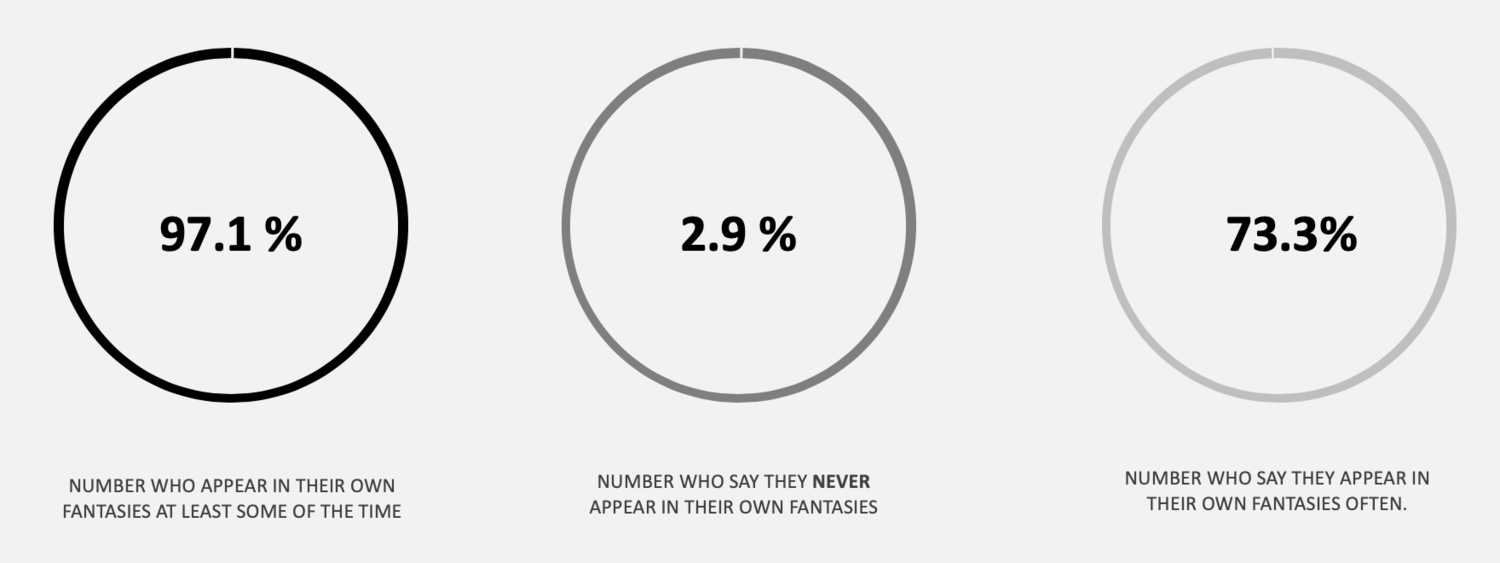How We See Ourselves in Our Sexual Fantasies, and What It Means
July 17, 2020 by Justin Lehmiller
When you fantasize about sex, do you appear in your own fantasies? If so, do you appear as you do in real life, or do you change yourself in some way?
I studied the sexual fantasies of 4,175 Americans from all 50 states for my book Tell Me What You Want, and one of the many things I looked at was the way that we see ourselves. What I found was that many people change some aspect of themselves, such as their body, their genitals, or their personality. However, I found that different people change themselves in very different ways, and that the types of changes people make seem to say something about them, as well as our broader culture.
First, I asked people whether or not they appear in their own fantasies at least some of the time, and almost everyone (97.1%) said yes. Further, most people said they appear in their own fantasies most of the time.

While most of us appear in our own fantasies, most of us see at least a somewhat different version of ourselves than exists in reality. A majority reported having changed their body type or shape, their genital appearance, their personality, and their sexual role (i.e., becoming more dominant or more submissive). Nearly half also reported having changed their age, becoming either a younger or older version of the self. For specific numbers, check out the figure below.

While changing oneself in one’s fantasies seems to be pretty common, I found that different types of people tended to change themselves in different ways. Notably, there were some pretty sizable differences across genders and sexual orientations.
For example, self-identified women (regardless of sexual orientation) were more likely to change their bodies than were self-identified men. However, gay and bisexual men were more likely than heterosexual men to change their bodies.
By contrast, men (regardless of sexual orientation) were more likely than women to change their genital appearance—but gay and bisexual men were even more likely than heterosexual men to do so.
When it came to age, men across the board were more likely to fantasize about themselves at a younger age, while women were more likely to fantasize about a future version of themselves. One of the most sizable differences here was a majority of heterosexual men had fantasized about being young again, while only about one-third of heterosexual women said the same. (Sidebar: perhaps this is partly due to gender differences in sexual regret. Men are more likely than women to fantasize about missed opportunities, so maybe men are fantasizing about being younger more often because they’re going back to “the one who got away.”)
When it came to changing one’s personality, gay and bisexual men were the most likely to report this—in fact, about three-quarters of them had done so, compared to about half of heterosexual men. Women (regardless of sexual orientation) fell in between.
Lastly, with respect to changing one’s sexual role, I looked at how dominant and submissive people said they were in reality compared to how often they fantasized about taking on dominant and submissive roles. The key finding that emerged there was that, among heterosexuals, women were more likely than men to fantasize about becoming more dominant than they actually were; by contrast, men were more likely than women to fantasize about becoming more submissive than they actually were.
With respect to persons who had non-binary gender identities, they were the group most likely to change themselves in their fantasies in almost all ways. The one exception was that they were less likely to fantasize about being themselves at a younger age. Why do non-binary folks change themselves the most? Perhaps because many of them are gender fluid—and if one’s gender expression changes in real life, one’s gender expression might also change in fantasies to reflect that. More generally, fantasies might also simply be a way for many folks to explore their gender expression.
So what do all of these changes mean? For one thing, they may say something about our personality. For example, introverted people fantasized more about changing their personality and becoming more dominant; extraverts were less likely to change themselves in any way. Neurotic individuals (those who don’t deal well with stress and who have more emotional instability) fantasized more about changing both their bodies and personalities. Interestingly, conscientious people (those who are more detail-oriented and organized) were the least likely to fantasize about changing any aspect of the self—their attention to detail appears to make them more likely to focus on the details in their fantasies.
These changes may also say something about our attachment style. People with both anxious and avoidant attachment styles were more likely to change themselves in all ways. I suspect this is because the anxious folks (those who have abandonment issues) are soothing their concerns and becoming a version of the self that doesn’t have to worry about being rejected (I suspect the same is true in the case of neuroticism, discussed above). By contrast, I suspect the avoidant folks (those who have major discomfort with intimacy) are literally becoming other people in their fantasies in order to create more emotional distance.
Lastly, these changes may say something about our culture. For instance, the fact that women changed their bodies more than men speaks to all of the media pressure that exists on women to be thin and to have a very specific appearance. Likewise, the fact that men were more likely than women to change their genitals may speak to the “bigger is better” messaging that men receive through porn and other sources that give unrealistic expectations about what the average penis actually looks like.
Also, the fact that gay and bisexual men were more likely than heterosexual men to change almost everything about themselves (body, genitals, personality) may be explained by sexual minority men facing a lot of pressure to conform to masculine body and behavior ideals (the “masc 4 masc” phenomenon prevalent on gay dating apps).
With all of that said, it’s important to note that changing yourself in your fantasies doesn’t always have deeper meaning—and it definitely doesn’t always reveal some type of insecurity. For example, people with very active imaginations often fantasize about changing themselves or becoming someone else simply because they fantasize more about almost everything.
As Freud himself once said, “sometimes a cigar is just a cigar.”
Want to learn more about the science of sexual fantasies? Check out Tell Me What You Want, now available in paperback! Exclusive offer for readers of the blog: order Tell Me What You Want and receive a bonus package that includes an extra chapter and some fun fantasy infographics. Click here for complete details.
Want to learn more about Sex and Psychology? Click here for more from the blog or here to listen to the podcast. Follow Sex and Psychology on Facebook, Twitter (@JustinLehmiller), or Reddit to receive updates. You can also follow Dr. Lehmiller on YouTube and Instagram.
Image Source: iStockphoto
You Might Also Like:

Dr. Justin Lehmiller
Founder & Owner of Sex and PsychologyDr. Justin Lehmiller is a social psychologist and Research Fellow at The Kinsey Institute. He runs the Sex and Psychology blog and podcast and is author of the popular book Tell Me What You Want. Dr. Lehmiller is an award-winning educator, and a prolific researcher who has published more than 50 academic works.
Read full bio >


